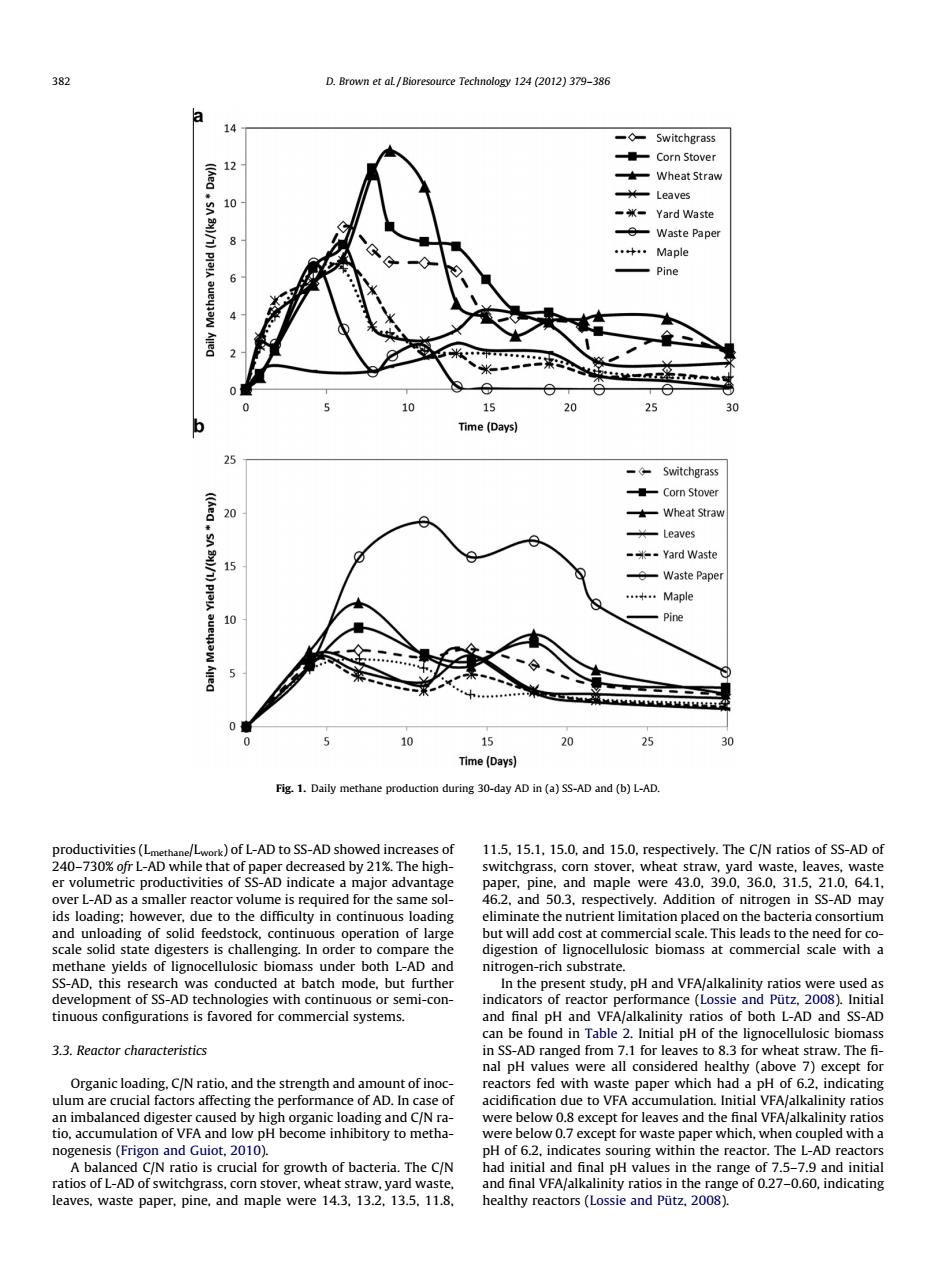正在加载图片...

382 D.Brown et aL/Bioresource Technology 124(2012)379-386 14 -◇-5 witchgrass Corn Stover ((Aea 12 ★-Wheat Straw Leaves 10 --Yard Waste -Waste Paper 8 +Maple -Pine o 30 Time(Days) 25 -Switchgrass ■-Corn Stover t一Wheat Straw Leaves -米-Yard Waste 15 Waste Paper ...Maple 10 Pine 5 0 10 30 Time(Days) Fig.1.Daily methane production during 30-day AD in (a)SS-AD and (b)L-AD. productivities(Lmethane/Lwork)of L-AD to SS-AD showed increases of 11.5,15.1,15.0,and 15.0,respectively.The C/N ratios of SS-AD of 240-730%ofr L-AD while that of paper decreased by 21%.The high- switchgrass,corn stover,wheat straw,yard waste,leaves,waste er volumetric productivities of SS-AD indicate a major advantage paper,pine,and maple were43.0.39.0.36.0.31.5,21.0.64.1, over L-AD as a smaller reactor volume is required for the same sol- 46.2.and 50.3,respectively.Addition of nitrogen in SS-AD may ids loading:however,due to the difficulty in continuous loading eliminate the nutrient limitation placed on the bacteria consortium and unloading of solid feedstock,continuous operation of large but will add cost at commercial scale.This leads to the need for co- scale solid state digesters is challenging.In order to compare the digestion of lignocellulosic biomass at commercial scale with a methane yields of lignocellulosic biomass under both L-AD and nitrogen-rich substrate. SS-AD,this research was conducted at batch mode,but further In the present study,pH and VFA/alkalinity ratios were used as development of SS-AD technologies with continuous or semi-con- indicators of reactor performance (Lossie and Putz,2008).Initial tinuous configurations is favored for commercial systems. and final pH and VFA/alkalinity ratios of both L-AD and SS-AD can be found in Table 2.Initial pH of the lignocellulosic biomass 3.3.Reactor characteristics in SS-AD ranged from 7.1 for leaves to 8.3 for wheat straw.The fi- nal pH values were all considered healthy (above 7)except for Organic loading,C/N ratio,and the strength and amount of inoc- reactors fed with waste paper which had a pH of 6.2,indicating ulum are crucial factors affecting the performance of AD.In case of acidification due to VFA accumulation.Initial VFA/alkalinity ratios an imbalanced digester caused by high organic loading and C/N ra- were below 0.8 except for leaves and the final VFA/alkalinity ratios tio,accumulation of VFA and low pH become inhibitory to metha- were below 0.7 except for waste paper which,when coupled with a nogenesis(Frigon and Guiot,2010). pH of 6.2,indicates souring within the reactor.The L-AD reactors A balanced C/N ratio is crucial for growth of bacteria.The C/N had initial and final pH values in the range of 7.5-7.9 and initial ratios of L-AD of switchgrass,corn stover,wheat straw,yard waste, and final VFA/alkalinity ratios in the range of 0.27-0.60,indicating leaves,waste paper,pine,and maple were 14.3,13.2,13.5,11.8, healthy reactors (Lossie and Puitz,2008).productivities (Lmethane/Lwork) of L-AD to SS-AD showed increases of 240–730% ofr L-AD while that of paper decreased by 21%. The higher volumetric productivities of SS-AD indicate a major advantage over L-AD as a smaller reactor volume is required for the same solids loading; however, due to the difficulty in continuous loading and unloading of solid feedstock, continuous operation of large scale solid state digesters is challenging. In order to compare the methane yields of lignocellulosic biomass under both L-AD and SS-AD, this research was conducted at batch mode, but further development of SS-AD technologies with continuous or semi-continuous configurations is favored for commercial systems. 3.3. Reactor characteristics Organic loading, C/N ratio, and the strength and amount of inoculum are crucial factors affecting the performance of AD. In case of an imbalanced digester caused by high organic loading and C/N ratio, accumulation of VFA and low pH become inhibitory to methanogenesis (Frigon and Guiot, 2010). A balanced C/N ratio is crucial for growth of bacteria. The C/N ratios of L-AD of switchgrass, corn stover, wheat straw, yard waste, leaves, waste paper, pine, and maple were 14.3, 13.2, 13.5, 11.8, 11.5, 15.1, 15.0, and 15.0, respectively. The C/N ratios of SS-AD of switchgrass, corn stover, wheat straw, yard waste, leaves, waste paper, pine, and maple were 43.0, 39.0, 36.0, 31.5, 21.0, 64.1, 46.2, and 50.3, respectively. Addition of nitrogen in SS-AD may eliminate the nutrient limitation placed on the bacteria consortium but will add cost at commercial scale. This leads to the need for codigestion of lignocellulosic biomass at commercial scale with a nitrogen-rich substrate. In the present study, pH and VFA/alkalinity ratios were used as indicators of reactor performance (Lossie and Pütz, 2008). Initial and final pH and VFA/alkalinity ratios of both L-AD and SS-AD can be found in Table 2. Initial pH of the lignocellulosic biomass in SS-AD ranged from 7.1 for leaves to 8.3 for wheat straw. The fi- nal pH values were all considered healthy (above 7) except for reactors fed with waste paper which had a pH of 6.2, indicating acidification due to VFA accumulation. Initial VFA/alkalinity ratios were below 0.8 except for leaves and the final VFA/alkalinity ratios were below 0.7 except for waste paper which, when coupled with a pH of 6.2, indicates souring within the reactor. The L-AD reactors had initial and final pH values in the range of 7.5–7.9 and initial and final VFA/alkalinity ratios in the range of 0.27–0.60, indicating healthy reactors (Lossie and Pütz, 2008). Fig. 1. Daily methane production during 30-day AD in (a) SS-AD and (b) L-AD. 382 D. Brown et al. / Bioresource Technology 124 (2012) 379–386